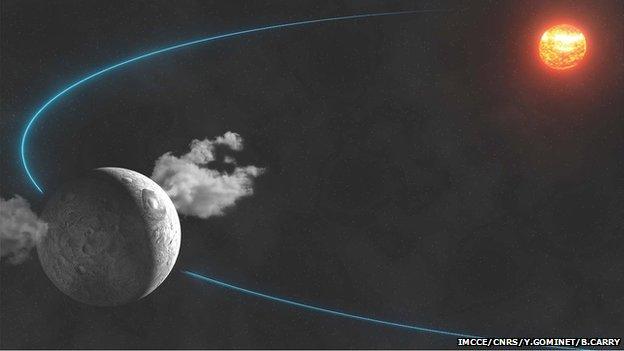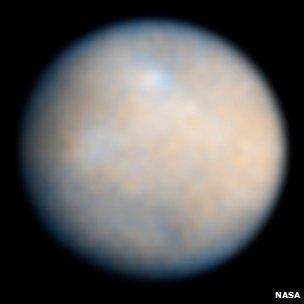Ceres asteroid vents water vapour
- Published

An artist's impression of water out-gassing from two sources on Ceres
Observations of the Solar System's biggest asteroid suggest it is spewing plumes of water vapour into space.
Ceres has long been thought to contain substantial quantities of ice within its body, but this is the first time such releases have been detected.
The discovery was made by Europe's infrared Herschel space telescope, and is reported in the journal Nature, external.
Scientists believe the vapour is coming from dark coloured regions on Ceres' surface, but are not sure of the cause.
One idea is that surface, or near-surface, ice is being warmed by the Sun, turning it directly to a gas that then escapes to space.
"Another possibility," says the European Space Agency's Michael Kuppers, "is that there is still some energy in the interior of Ceres, and this energy would make the water vent out in a similar way as for geysers on Earth, only that with the low pressure at the surface of the asteroid, what comes out would be a vapour and not a liquid."
The quantity being out-gassed is not great - just 6kg per second - but the signature is unmistakable to Herschel, external, which was perfectly tuned to detect water molecules in space.
The telescope's observations were made before its decommissioning last year.

Currently, our best image of Ceres comes from the Hubble Space Telescope
Scientists will get a better idea of what is going on in 2015, when Ceres is visited by the American space agency's Dawn probe, external.
The satellite will go into orbit around the 950km-wide body, mapping its surface and determining its composition and structure.
"It will be able to observe those dark regions at high resolution, and will probably solve the question of what process is creating the water vapour," explained Dr Kuppers.
Ceres is often now referred to as a "dwarf planet" - the same designation used to describe Pluto following its demotion from full planet status in 2006.
The asteroid's sheer size means gravity has pulled it into a near-spherical form.
It is regarded as quite a primitive body in that it has clearly not undergone the same heating and processing of its materials that the many other objects in the asteroid belt between Mars and Jupiter have experienced.
Scientists suspect water-ice is buried under Ceres' crust because its density is less than that of the Earth's. And this reputation as a "wet body" is supported by the presence of a lot of minerals at its surface that have water bound into their structure.
One theory to explain why Ceres has so much more water-ice than other members of the surrounding asteroid population is that it formed further away from the Sun, and only later migrated to its present location.
This could have happened if perturbed by Jupiter, whose gravity plays a key role in corralling the asteroids in the belt they occupy today.
"We now have a more sophisticated model for the evolution of the Solar System called the Nice model, which successfully explains many of the features of the Solar System, with the planets having migrated outwards and then maybe also inwards," said Dr Kuppers.
Jonathan.Amos-INTERNET@bbc.co.uk and follow me on Twitter: @BBCAmos, external
- Published17 June 2013
- Published12 December 2013
- Published28 April 2010